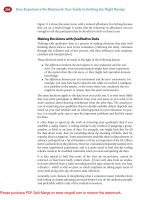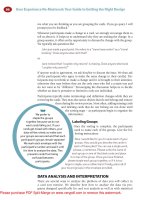Bam! Your Guide to Digital Comic Books
Bạn đang xem bản rút gọn của tài liệu. Xem và tải ngay bản đầy đủ của tài liệu tại đây (3.39 MB, 61 trang )
Bam! Your Guide to
Digital Comic Books
By Lachlan Roy,
Edited by Justin Pot
This manual is the intellectual property of
MakeUseOf. It must only be published in its
original form. Using parts or republishing altered
parts of this guide is prohibited without permission
from MakeUseOf.com
Think you’ve got what it takes to write a manual
for MakeUseOf.com? We’re always willing to
hear a pitch! Send your ideas to
; you might earn up to
$400.
Table of Contents
Introduction
Digital Comic Books
Finding Comic Books
Reading Comic Book Files
Online Comic Books
Graphicly - the best of both worlds?
Webcomics
Conclusion
MakeUseOf
Introduction
Superman.
Spider-man.
Batman.
The X-Men.
Even if you’ve never picked up a comic book in
your life, you’ve almost certainly heard of these
legends. Ever since the 1930s superheroes have
been here to stay. They’ve taken the world by
storm time and time again. They’ve worked
together, fought together and against each another
in nearly every thinkable combination. With almost
80 years of back-story just think of the rich history
to be discovered. And that’s just for the famous
ones. Think of the hundreds of other heroes, each
with their own back-stories, their own
archenemies.
And that’s just the superheroes.
Romance. Drama. Sci-fi. Fantasy. Horror. Crime.
Comedy. There are comics for all genres, comics
for all ages.
Wouldn’t it be great to have access to all those
stories? To be able to read the epic tales of great
people having great adventures?
“But comic books are expensive!” I hear you say.
“Besides, wherever would I keep them all? I don’t
have time to find a comic book store, let alone
spend time looking through all the books to find
what I want!”
I might have the solution for you.
Maybe that’s not you. You’ve already been
enlightened. You’ve been reading comic books for
years, and you’ve grown with the characters that
you love so much along with the collection that
archives their adventures.
What would happen if something were to happen to
your beloved comic books? What if they were
stolen? What if there was a fire?
I think I have a solution for you, too.
Digital comic books. They may not give you the
feeling of freshly printed paper or that strange
sensation you get from opening a new issue for the
first time, but they come pretty close. Interested?
Read on.
Digital Comic Books
Offline/Local Comic Books
The first kind of digital comic books that I’ll be
talking about is the Comic Book file. While they’re
rarely used for new comic books to be purchased,
they have their own uses. Comic book files are
perfect for creating digital archives of comic
books you already own.
The other main use for comic book files is for
reading comics which would otherwise be
impossible to obtain or read, such as Japanese
manga. There are many series that are great to read
but will likely never be translated to English and
distributed outside of Japan; these are translated by
fans and distributed online. This is called
scanlating (a cross between scanning and
translating), and is admittedly at best described as
a moral grey area.
Finally, it is possible to buy comic books to
download and store on your computer through web
stores such as Wowio (more on that later).
File formats
Digital comic books come in many daunting guises,
but they’re not as different or as mysterious as you
might think.
Most digital comic book files are little more than
an archive filled with image files – one image per
page. If you open one of these archives it’ll look
something like this:
Even though they work in the same way, there are
still plenty of different formats that you might come
across, so here’s a quick list.
CBR
CBR stands for Comic Book R. I know: that
doesn’t really go a lot further to explaining what it
is. It’s quite simple – the „R’ comes from the fact
that a CBR file is little more than a renamed RAR
archive.
In fact, although a file with the .cbr extension can
be opened almost exclusively by comic book
readers, once that file has had its extension
changed to .rar it can be opened by most archive
applications.
CBZ
Just like CBR files are just renamed RAR
archives, CBZ files are just renamed ZIP archives.
There’s not much more to it than that!
CB7
In the same way, you can probably guess that CB7
files are simply renamed 7z archives.
ZIP
Most comic book reader apps have support for
normal .zip files too, which are a whole lot more
common than their Comic Book File relatives.
There’s the added bonus that you don’t need to
modify the file to open it to get to the files inside.
The last particularly common type of comic book
you’ll find is packaged as a PDF, just like the
guide you’re reading right now. These have their
own advantages; you can usually read a PDF
without any special sort of program, regardless of
the computer you use. They can take up more space
and be more difficult to work with than other
formats, however.
Golden Age Comics
The vast majority of comics that you’ll find that
you can download are from the Golden Age of
comics – that is, comics that were published
between the late 1930s and the early 1950s. Many
of these comics are now in the public domain,
meaning that they are no longer covered by
copyright and are free for anyone to download.
Golden Age comics are known mostly for the
introduction of the archetypal superheroes such as
Superman, Wonder Woman and Batman. While
large publishers closely guard these popular
characters, they gave rise to hundreds of smaller,
lesser-known superheroes with all sorts of
superpowers that are freely available.
There are a few places for getting public domain
comics, with the most noteworthy probably being
the Digital Comic Museum. It requires you to sign
up to download files but it is free.
Modern Age Comic Books
While still not particularly widespread, legal
modern comic book files are becoming more
common. Comic Book Files (such as .cbr files) are
often used by independent artists to distribute their
work offline. For example, Flashback Universe is
a group or artists and writers who have decided to
freely distribute their comics only as .cbr files in
order to raise awareness and push for a better
future for comic book distribution.
Examples like these have led rise to stores such as
Wowio which allow customers to buy books and
comic books and download them as DRM free
files. While Wowio takes a slightly different
approach to Flashback Universe and distributes
most of its comics as PDFs, the intent is the same.
Wowio might not be able to distribute content
which belongs to major publishers, but it’s a great
place to find comic books from brilliant artists
who would otherwise go unnoticed.
Take Last Blood, for example; a series in which
vampires must protect humans from a zombie
infested world in order to secure their dwindling
food source.
Making your own Comic Book
Files
Say you’ve got a collection of comic books that
you want to make sure are safe. They’re
understandably very precious to you, and you’d
hate it if anything happened to them.
As a precaution, you might want to consider
making your own Comic Book files. It’s a lot
easier than you might think – all you need is a
scanner!
The first step is by far the most consuming one –
you’ll need to use scanning software (which should
have come with your scanner) to scan each page
onto your computer. More advanced scanning
software can automatically straighten your scanned
pages as well as making it easy to split double
pages.
You’ll want to fiddle around and find out the
perfect settings for you before you get started.
Higher quality scans look great and capture more
detail, but take longer to scan each page and will
take up quite a bit more space. However, if you’ve
got the time and the hard drive space then it’s
definitely worth having a high-quality backup of
your beloved comics.
Ideally the scans can be saved as a series of
sequentially numbered JPEG files. This shouldn’t
be a problem as it’s the default operation for most
scanning software, but it’s important that you get
the numbering right, as this is what a comic book
reader will use to order the images once you’re
done.
The next step is to add all the images into an
archive file. It’s important that the files are in the
root of the archive (that is, they’re not in a folder
within the archive), otherwise the reader won’t be
able to open them! Windows, OS X and Linux all
have tools to create archives (“Send to >
Compressed (zipped) folder” in Windows and
“Create Archive” in OS X and Ubuntu), so this
doesn’t require any special software. The final
step is to turn the archive into a Comic Book file.
Chances are the archive that you’ve created is a
.zip file; if so, rename the file extension from
“.zip” to “.cbz”. If you’ve made a .rar archive,
rename it to “.cbr”, and if you’ve made a .7z
archive, rename it to “.cb7”
That’s all there is to it! It can be a lot of work, but
ultimately it’s worth it to have a digital copy
archived away just in case something happens to
your physical copy.
Reading Comic Books Files
Unfortunately there isn’t a recent, supported
application that runs on all three major operating
systems. However, there are some great
applications out there for each platform. Let’s take
a look at some of the major ones.
Windows
ComicRack is by far the most popular comic book
reader for Windows. It is often referred to as
“iTunes for comic books”, and it’s easy to see
why. ComicRack is as much a comic book library
as it is a reader, with a lot of features such as
conversion between most popular Comic Book file
formats that gives it functionality similar to
calibre, too.
Installing ComicRack is just like installing any
other Windows application, so you shouldn’t have
any problems. Just download the .exe file from
ComicRack’s download page and you’ll be good
to go.
ComicRack automatically makes itself the default
application for any comic book files (that is, CBR,
CBZ and CB7 files). To add a folder to the
ComicRack library (and all of the comic books
inside), you can click on “File > Add Folder to
Library ” and browse to the folder that contains
all of your comic books.
For more information, you can read more about
ComicRack over on the main MakeUseOf site,
courtesy of Simon.
Mac OS X
On the opposite end of the spectrum, with
relatively few features, is one of the favourite
comic book readers for Mac OS X: Simple Comic.
As you might suspect from the name, Simple
Comic focuses on doing what it does well: reading
comics, and nothing else, instead of piling on
features and creating an entire library for your
comic books
Simple Comic has support for all the major files
(and some less common ones, too) as well as a
few features which make reading that little bit
more enjoyable, like a loupe for looking at small
details and being able to choose whether comic
books read left to right or from right to left (useful
for reading Japanese manga).
To use Simple Comic, simply download it from the
website, extract the application from its zip file
and put it in your Applications folder. Then, right
click on any Comic Book file, click “Get Info ”
before selecting Simple Comic from the drop
down menu under “Open with:”.
Ubuntu
Your best bet for a comic reader for Ubuntu, and
most Linux distributions, seems to be a program
called Comix. This is closer to Simple Comic than
ComicRack in that Comix is deliberately made to
be a lightweight reader rather than a library
application. You can get it by downloading it from
the Ubuntu Software Centre or by downloading the
binary from SourceForge (check the link).
The only downside to Comix is that it doesn’t
support rar files out of the box (or, by extension,
.cbr files). However, this is easily fixed by
installing “unrar” from the Ubuntu Software Centre
or your distribution’s package manager.









